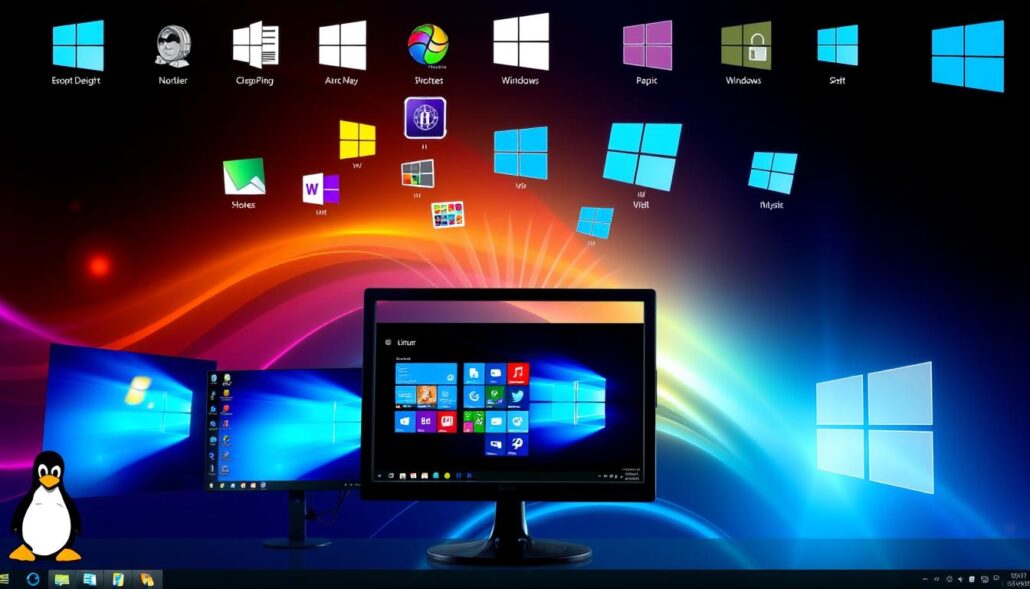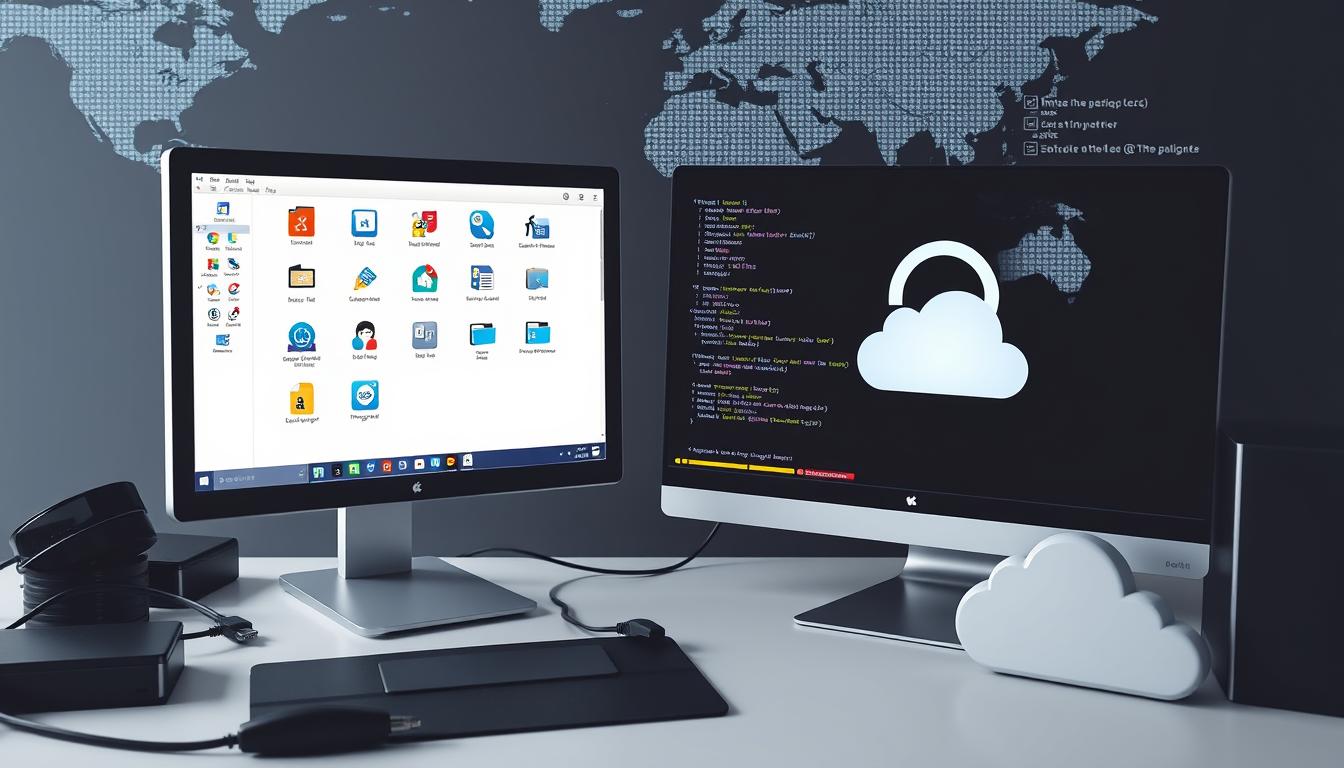If you use Linux, you might find it hard to run Windows apps without native versions. Luckily, Wine is here to help. It lets you run Windows software on Linux easily. This guide will show you how to install, set up, and run Windows apps on Linux with Wine.
Wine is a tool that makes it possible to run many Windows apps on Linux. It’s great because lots of popular software, like productivity tools and games, are made for Windows. With Wine, you can use a huge variety of Windows software on your Linux machine.
Key Takeaways
- Wine is a compatibility layer that enables running Windows applications on Linux systems.
- Linux users can access a wide range of Windows software by installing and configuring Wine.
- Wine provides a seamless way to integrate Windows applications into the Linux environment.
- The installation process for Wine varies across different Linux distributions, but the general steps are straightforward.
- Configuring Wine may require some additional tweaks and troubleshooting, especially for complex or game-related applications.
What is Wine?
Wine is short for “Wine Is Not an Emulator.” It’s an open-source layer that lets users run Windows apps on Linux and other Unix-like systems. Unlike emulators, Wine doesn’t just mimic the Windows system. It translates Windows API calls into POSIX calls in real-time. This gives better performance and smooth integration with Linux.
Understanding Wine’s Role in Running Windows Apps on Linux
Wine bridges the gap between Windows and Linux. It lets Linux users run a wide range of Windows software, even if there’s no native Linux version. This makes Linux more versatile, allowing users to run important Windows apps without needing a separate Windows install or virtualization software.
Wine can handle many types of Windows programs. This includes productivity suites, business tools, games, and multimedia apps. It emulates the Windows environment, giving Linux users the same functionality and experience as on a Windows system.
The latest Wine version, 1.6, is available through WineHQ. Many Linux distributions, like Ubuntu, also offer Wine in their repositories. This makes it easy for users to get the latest and most stable version.
“Wine is a remarkable piece of software that has revolutionized the way Linux users interact with Windows applications. It has truly expanded the possibilities of the Linux operating system.”
Installing Wine on Linux Distributions
If you use Linux and need to run Windows apps, Wine is a great tool. It acts as a bridge between Windows and Linux. Installing Wine is easy, but the steps vary by Linux version.
Ubuntu and Debian-based Systems
For Ubuntu and similar systems, follow these steps:
- Open the Terminal by pressing Ctrl + Alt + T.
- Update the software list with
sudo apt update. - Install needed packages with
sudo apt install software-properties-common. - Add the WineHQ repository with
sudo add-apt-repository 'deb https://dl.winehq.org/wine-builds/ubuntu/ focal main'. - Install Wine with
sudo apt install winehq-stable.
Fedora and Red Hat-based Systems
Fedora and Red Hat users have a different setup:
- Open the Terminal by pressing Ctrl + Alt + T.
- Enable the WineHQ repository with
sudo dnf config-manager --add-repo https://dl.winehq.org/wine-builds/fedora/33/winehq.repo. - Install Wine with
sudo dnf install winehq-stable.
Arch Linux and Derivatives
Arch Linux and Manjaro users can install Wine with pacman:
- Open the Terminal by pressing Ctrl + Alt + T.
- Install Wine with
sudo pacman -S wine.
Once you’ve installed Wine, you can run Windows apps on your Linux system.

Configuring Wine for Windows App Compatibility
Configuring Wine is key to running Windows apps on Linux. Open the Wine configuration window (winecfg) to set the right Windows version. This lets Wine translate Windows API calls, making your software run well on Linux.
Wine offers several options. Stable versions are bug-free and updated every 3-6 months. Development versions get updates every 2 weeks, focusing on better compatibility and performance. Staging versions include the latest features from Wine-Staging.
To install the recommended stable Wine version, use specific terminal commands for your Linux. The Wine Application Database helps find needed components for apps. Winetricks is great for installing extra components and libraries to improve Wine’s compatibility.
| Wine Version | Update Frequency | Focus |
|---|---|---|
| Stable | Every 3-6 months | Stability |
| Development | Every 2 weeks | Compatibility and Performance |
| Staging | Varies | Bleeding-edge Features |
Fixing Wine app issues can be tricky. Frozen apps, unknown DLLs, or missing components are common problems. Setting up a virtual desktop can help with frozen apps. Tools like CDEMU are useful for apps like Sims 3 or Simcity 2000.
By setting up Wine and knowing the different versions and tools, you can make Windows apps work on Linux. This way, you get the best of both worlds.
How to Run Windows Applications on Linux Using Wine
Installing and Launching Windows Apps with Wine
Wine makes it easy to run Windows apps on Linux. It’s a powerful tool that lets you install and launch many Windows programs right on your Linux system. You don’t need a separate Windows OS.
First, download the .exe installer for the Windows app you want. Then, open your Linux terminal and go to the file’s directory. Use the command “wine setup.exe” (or the installer’s name) to start the install.
Once installed, you can launch the app with “wine application.exe”. Just replace “application.exe” with your app’s name. This lets you use the Windows program smoothly in Linux.
Wine works with many Windows versions, including Windows 11, 10, 8.1, and 7. You can also create separate Wine prefixes for different apps. This helps keep things running smoothly and efficiently.
The wine wineboot command is useful too. It lets you “reboot” Wine when Windows apps need a real reboot. This adds more flexibility when managing your Windows apps on Linux.
With Wine, you can run Windows apps on Linux. This way, you get the best of both worlds. You enjoy Linux’s stability and security while using the software you need.
| Wine Command | Description |
|---|---|
| wine –version | Check the current version of Wine installed |
| wine winecfg | Open the Wine configuration tool |
| wine SomeWinApp.exe | Launch a Windows application |
| wine start SomeWinApp.exe | Launch a Windows application in the background |
| wine msiexec /i SomeWinApp.msi | Install a Windows application from an .msi file |
| wine uninstaller | Uninstall a Windows application |
Learning these Wine commands will help you run Windows apps on Linux. It unlocks your Linux system’s full potential.

“Wine allows me to use all the Windows apps I need on my Linux machine, without the hassle of dual-booting or virtualization. It’s a game-changer for my productivity!”
Tips for Running Windows Games on Linux with Wine
Running Windows games on Linux with Wine can be rewarding. It might need some tweaking for the best performance. With a few strategies, you can get the most out of Wine and enjoy smooth gaming.
Optimizing Performance and Installing DirectX
Installing DirectX correctly is key for running Windows games on Linux with Wine. Many games use DirectX for graphics. So, installing DirectX through Winetricks can boost performance and make games work better.
Also, tweaking Wine settings with winecfg can greatly improve game performance. Adjusting virtual desktop settings, graphics, and other system parameters can make games run smoother and more stable.
- Install DirectX components using Winetricks:
- Open Winetricks and pick “Install DirectX”.
- Just follow the instructions to install DirectX.
- Open winecfg and go to the “Graphics” tab.
- Check “Allow the window manager to control the window” for better performance.
- Try different settings like “Desktop size” and “Graphics driver” to find what works best for you.
By following these steps, you can get the most out of Wine. This way, you can enjoy playing Windows games on your Linux system without any trouble.
| Linux Distribution | Wine Performance Optimization | DirectX Installation |
|---|---|---|
| Ubuntu | Adjust settings in winecfg | Install through Winetricks |
| Fedora | Tweak Wine configuration files | Use Winetricks or manual installation |
| Arch Linux | Leverage Arch-specific Wine tools | Install DirectX with Winetricks |
“Wine has been a game-changer for me, allowing me to run my favorite Windows games on my Linux system without any major issues. The performance optimization and DirectX installation tips have been crucial in ensuring a seamless gaming experience.”
Leveraging Winetricks for Additional Configurations
Dealing with Windows apps on Linux can be tough. But Winetricks makes it easier. It’s a script by Dan Kegel that helps install libraries for Windows apps on Wine. This way, you can tweak Wine to run specific Windows software better.
Winetricks is great when a Windows app needs special libraries not found in Wine. It lets you add these components easily. This makes running Windows programs on Linux smoother.
Using Winetricks to Enhance Wine Configurations
To use Winetricks for better Wine additional configurations and Windows app compatibility, just follow these steps:
- First, install Winetricks for your Linux, like Ubuntu or Fedora.
- Then, open a terminal and type the Winetricks command to start it.
- Look through the options and pick the components your Windows app needs.
- Winetricks will download and install them for you. This boosts your Winetricks tool setup and makes Windows apps work better on Linux.
Winetricks opens up new possibilities. It lets your favorite Windows apps run smoothly on Linux. You won’t lose out on the experience.
“Winetricks is an essential tool for anyone looking to run Windows software on their Linux machine. It’s a game-changer when it comes to addressing compatibility issues and customizing the Wine configuration.”
Keep in mind, the world of Wine additional configurations and Windows app compatibility keeps changing. So, it’s key to keep up with Winetricks updates and community tips. This way, your Windows apps will keep running well on Linux.
Community Support and Resources
The Wine community is full of life and offers many resources for those wanting to run Windows apps on Linux. You can find help on the WineHQ forums and the Wine Application Database (AppDB). These places are packed with tips, troubleshooting advice, and support to help you through the Wine world.
The WineHQ forums are a great place for Wine users. Here, you can get help from experienced folks who are always ready to assist. Whether you’re new or have been using Wine for a while, the forums are a treasure trove of information and advice.
The Wine Application Database (AppDB) is another key resource. It lists how well different Windows apps work with Wine. Apps are rated from “Platinum” for perfect performance to “Garbage” for those that don’t work at all. This database is crucial for figuring out if you can run your favorite Windows apps on Linux with Wine.
Reddit is also a big part of the Wine community. The r/wine_gaming subreddit is a place for discussions, troubleshooting, and sharing experiences. It’s a great way to connect with others, learn from their experiences, and keep up with the latest in Wine and running Windows apps on Linux.
By using these community resources, Wine users can access a wealth of knowledge and help. Whether you’re a Linux pro or just starting with Wine, the support and resources available are incredibly valuable.
| Resource | Description |
|---|---|
| WineHQ Forums | A vibrant community of Wine users and experts where you can find solutions, ask questions, and stay updated on the latest developments. |
| Wine Application Database (AppDB) | A comprehensive database that provides compatibility ratings and information for various Windows applications running on Wine. |
| r/wine_gaming subreddit | An active Reddit community focused on discussions, troubleshooting, and sharing experiences related to running Windows games and applications on Linux with Wine. |
Alternatives to Wine: PlayOnLinux and Lutris
Wine is great for running Windows apps on Linux, but there are better options. PlayOnLinux and Lutris offer easier, more user-friendly ways to install and manage Windows software on Linux. They use Wine but add a graphical interface and pre-made scripts for easier setup.
PlayOnLinux: A Graphical Wine Interface
PlayOnLinux is a user-friendly front-end for Wine. It makes installing and setting up Windows apps on Linux simple. Its easy-to-use interface and pre-made scripts help users quickly get their favorite Windows programs running on Linux.
Lutris: A Gaming-Focused Alternative
Lutris is designed for gamers. It supports Windows apps and games on Linux. It has many pre-configured game runners, including Wine, for a smooth gaming experience on Linux.
PlayOnLinux and Lutris offer better alternatives to Wine. They are more user-friendly, with automated setup, troubleshooting tools, and community scripts. This makes running Windows software on Linux easier.
If you’re a casual user or a serious gamer, PlayOnLinux and Lutris are great choices. They provide a better experience than using Wine alone.
Conclusion
Running Windows apps on Linux with Wine opens up new possibilities. This powerful tool lets users mix Windows software with their Linux setup. This means they can use more apps and games, even if they’re not made for Linux.
The article has given a detailed guide on using Wine. It also talks about other tools like PlayOnLinux and Lutris. These tools help Linux users get the best of both worlds. They can enjoy Linux’s security and flexibility while using Windows software.
Wine lets Linux users run many Windows programs. These include important work tools and fun games. By following the guide, users can set up Wine easily. This makes running Windows apps on Linux smooth and efficient.
Whether you’re a developer, gamer, or professional, Wine is great. It bridges the gap between Linux and Windows. This opens up many opportunities for users.
The demand for running Windows apps on Linux will keep growing. Thanks to Wine, PlayOnLinux, and Lutris, Linux users will have more options. They can enjoy the best of both worlds, making their computing experience better.








Leave a Reply